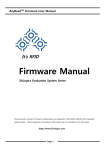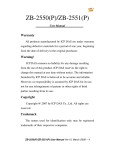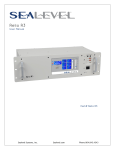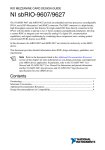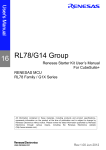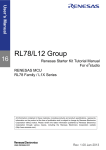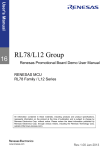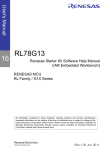Download RL78 Family Open Source FAT File System M3S-TFAT
Transcript
APPLICATION NOTE RL78 Family Open Source FAT File System M3S-TFAT-Tiny: Introduction R20AN0159EJ0103 Rev.1.03 Sep 01, 2014 Guide Introduction This document explains the usage of the Open Source FAT File System M3S-TFAT-Tiny for RL78 Family V.2.01 Release 00 (hereafter referred to as "TFAT library") along with a sample program. Please refer to the User's Manual to understand how to use the software library. User's Manual is in this application note. And, we prepared Sound Playback/Record demonstration software for the YRDKRL78G14 as sample application program for TFAT Library. Please refer to the following URL for details. http://www.renesas.com/products/tools/middleware_and_drivers/tiny_soft/adpcm/m3s_s2_tiny/app_notes.jsp (Document NO.: R20AN0194) Target Device RL78/G14 R20AN0159EJ0103 Rev.1.03 Sep 01, 2014 Page 1 of 15 RL78 Family Open Source FAT File System M3S-TFAT-Tiny: Introduction Guide Contents 1. Structure of application note ......................................................................................... 3 2. Specification of library ................................................................................................... 4 2.1 Specification of TFAT library ..................................................................................................... 4 2.2 Structure of software stack ........................................................................................................ 4 3. For CubeSuite+ ............................................................................................................... 5 3.1 Development environment ......................................................................................................... 5 3.2 Compiler option for generating library ..................................................................................... 5 3.3 Version information .................................................................................................................... 5 3.4 ROM size / RAM size / Stack size............................................................................................... 6 3.5 Performance ................................................................................................................................ 7 3.6 Notes ............................................................................................................................................ 7 4. For IAR Embedded Workbench ..................................................................................... 8 4.1 Development environment ......................................................................................................... 8 4.2 Compiler Option .......................................................................................................................... 8 4.3 Version information .................................................................................................................... 8 4.4 ROM size / RAM size / Stack size............................................................................................... 9 4.5 Performance .............................................................................................................................. 10 4.6 Notes .......................................................................................................................................... 10 5. Usage of Libraries ........................................................................................................ 11 6. Sample program ........................................................................................................... 12 6.1 Outline ........................................................................................................................................ 12 6.2 Sample software execution ...................................................................................................... 12 6.3 Flow ............................................................................................................................................ 13 R20AN0159EJ0103 Rev.1.03 Sep 01, 2014 Page 2 of 15 RL78 Family 1. Open Source FAT File System M3S-TFAT-Tiny: Introduction Guide Structure of application note This application note includes files below. Table 1 Structure of application note name r20an0159ej0103_rl78_tfat.pdf Workspace (workspace) Document (doc) English (en) description Introduction Guide (this document) r20uw0078ej0200_tfat.pdf User's Manual r20an0159ej0103_rl78_tfat.pdf Introduction Guide (this document) Japanese (ja) r20uw0078jj0200_tfat.pdf r20an0159jj0103_rl78_tfat.pdf IAR (IAR) Library (lib) User's Manual Introduction Guide TFAT library (Device / Code model / Data model) tfat_rl78_core_s2_m.r87 RL78 core S2 - Unspecified / Far / Near tfat_rl78_core_s3_m.r87 RL78 core S3 - Unspecified / Far / Near r_tfat_lib.h Library header file r_stdint.h Integer type define header file r_mw_version.h Version number definition file Library generation environment (make_lib) Library source directory (src) Public Include header directory (pub_include) Build environment directory (tfat_rl78_iar) CubeSuite+ (Cubesuite+) Library (lib) tfat_rl78.lib TFAT Library file ( Medium model) r_tfat_lib.h Library header file r_stdint.h Integer type define header file r_mw_version.h Version number definition file Library generation environment (make_lib) Library source directory (src) Public Include header directory (pub_include) Build environment directory (tfat_rl78) Sample program (sample) Sample program for RL78/G14 with MMC driver (TFAT_sample_RL78_with_MMC) Reference(ref) r20ut0684ej0010_rl78g14.pdf RL78/G14 64pin CPU board Circuit Diagram r20ut0685jj0010_rl78g15.pdf RL78/G14 64pin CPU board User's Manual (Japanese) r20ut0685ej0010_rl78g15.pdf RL78/G14 64pin CPU board User's Manual (English) Schematic_Design__RL78_Middleware_ Middleware Evaluation Board Circuit Diagram Evaluation_Board-V3_2.pdf R20AN0159EJ0103 Rev.1.03 Sep 01, 2014 Page 3 of 15 RL78 Family 2. Open Source FAT File System M3S-TFAT-Tiny: Introduction Guide Specification of library 2.1 Specification of TFAT library Following are some of the main specifications of the TFAT library. Table 2 Specification of TFAT library item Base program Supported FAT Type Filename Support Number of drives supported Logical Sector size Filesystem format function 2.2 specifications Fatfs (R0.06) FAT12, FAT16, FAT32 8.3 format (8 lettered filename & 3 lettered extension) Long file name format is not supported. 1 512byte None Structure of software stack Following are structure of software stack of the TFAT library. Application initialize librarys API FAT file system TFAT Library Driver I/F convert I/F device driver H/W Memory media Figure 2-1 structure of software stack of the TFAT library R20AN0159EJ0103 Rev.1.03 Sep 01, 2014 Page 4 of 15 RL78 Family 3. Open Source FAT File System M3S-TFAT-Tiny: Introduction Guide For CubeSuite+ 3.1 Development environment TFAT library can run with this development environment below. [Software tools] • Integrated Development Environment CubeSuite+ V2.02.00 • C compiler CubeSuite+ CA78K0R V1.70 [Debug tools] • Emulator debugger E1 emulator [Board] • RL78/G14 64pin CPU Board Renesas • Middleware Evaluation Board Renesas 3.2 type : R0K50104LC000BR (Please refer to Appendix) Compiler option for generating library Library file is built with compile option. It changed the following options from the default option. Add debug information : No(-ng) Output common object file for various devices : Yes(-common) 3.3 Version information TFAT library has version information as strings. User can access this version information to use extern variable defined in header file. define: extern const mw_version_t R_tfat_version; TFAT library has version information showed below. "M3S-TFAT-Tiny version 2.01 for RL78 (S2, MEDIUM).(Sep 11 2014, 20:29:07)" R20AN0159EJ0103 Rev.1.03 Sep 01, 2014 Page 5 of 15 RL78 Family 3.4 Open Source FAT File System M3S-TFAT-Tiny: Introduction Guide ROM size / RAM size / Stack size TFAT library requires ROM/RAM/Stack size as below. Table 3 ROM/RAM size kind size ROM (CSEG) about 12.7KB RAM (DSEG) 4byte Stack size [Note] about 200byte Note: Stack size is dependent on user-defined function. At least one variable of the structure FATFS is always required for FileSystem Work Area allocation. The FIL and DIR structures will be needed as per the requirement. The number of FIL variables needed is equal to the number of files that will be opened simultaneously by the user. If two files are to be opened simultaneously, then two FIL structure variables will be needed resulting in total memory consumption of 32 x 2 = 64 Bytes. Likewise will be the case with DIR and other structure variables. Table 4 structure size Structure FATFS FIL DIR FILINFO R20AN0159EJ0103 Rev.1.03 Sep 01, 2014 Memory for one structure variable [byte] 558 32 18 22 Page 6 of 15 RL78 Family 3.5 Open Source FAT File System M3S-TFAT-Tiny: Introduction Guide Performance The access time that TFAT library reads/write memory card is below. Table 5 Performance Test Condition Rl78/G14 Time to write 1MByte data file. (File Open , Data write ,File close) Time to read 1MByte data file. (File Open , Data read ,File close) Time About 4.8 Sec About 1.8 Sec Detail of test condition is below. Table 6 Measurement condition Detail of Test Condition RL78/G14 CPU Clock(fCLK) Memory FAT type Cluster size Driver software Source data area when data write. Destination data area when data read. 3.6 Contents 32MHz Transcend MMC 256MB FAT32 2048byte Renesas MMC driver (R20AN0158JJ0101) Internal ROM (Mirror area) Internal RAM Notes • Library is using the following standard function. memset memcmp memcpy • This library corresponds Medium model. When user use othe memory models with TFAT library, please re-build the library that corresponds to user memory models, using library build environment included in the package. R20AN0159EJ0103 Rev.1.03 Sep 01, 2014 Page 7 of 15 RL78 Family 4. Open Source FAT File System M3S-TFAT-Tiny: Introduction Guide For IAR Embedded Workbench 4.1 Development environment TFAT library can run with this development environment below. [Software tools] -Integrated Development Environment and C compiler IAR Embedded Workbench for Renesas RL78 version 1.40.2 -Code Gererator tool Applilet3 for RL78 V1.05.00 Renesas [board] The sample program that uses TFAT-IAR version is in the following Application note. Document title: Sound Playback/Compression demonstration software for RL78/G14 CPU board (Document number: R20AN0194) Please download the sample code clicking following URL. http://www.renesas.com/products/tools/middleware_and_drivers/tiny_soft/adpcm/m3s_s2_tiny/app_notes.jsp 4.2 Compiler Option This product is specifically built for RL78 with the following compiler options: tfat_rl78_core_s2_m.r87: --core rl78_1 --code_model far --data_model near --near_const_location rom0 -e -Oh --library_module tfat_rl78_core_s3_m.r87: --core rl78_2 --code_model far --data_model near --near_const_location rom0 -e -Oh --library_module 4.3 Version information TFAT library has version information as strings. User can access this version information to use extern variable defined in header file. define: extern const mw_version_t R_tfat_version; TFAT library has version information showed below. ・tfat_rl78_core_s2_m.r87: "M3S-TFAT-Tiny version 2.01 for RL78 (IAR, S2, code_model=far, data_model=near).(Sep 11 2014, 20:31:29)" ・tfat_rl78_core_s3_m.r87: "M3S-TFAT-Tiny version 2.01 for RL78 (IAR, S3, code_model=far, data_model=near).(Sep 11 2014, 20:31:46)" R20AN0159EJ0103 Rev.1.03 Sep 01, 2014 Page 8 of 15 RL78 Family 4.4 Open Source FAT File System M3S-TFAT-Tiny: Introduction Guide ROM size / RAM size / Stack size TFAT library requires ROM/RAM/Stack size as below. Table 7 ROM/RAM size kind size ROM (CSEG) about 12KB RAM (DSEG) 4byte Stack size [Note] about 200byte Note: Stack size is dependent on user-defined function. At least one variable of the structure FATFS is always required for FileSystem Work Area allocation. The FIL and DIR structures will be needed as per the requirement. The number of FIL variables needed is equal to the number of files that will be opened simultaneously by the user. If two files are to be opened simultaneously, then two FIL structure variables will be needed resulting in total memory consumption of 32 x 2 = 64 Bytes. Likewise will be the case with DIR and other structure variables. Table 8 structure size Structure FATFS FIL DIR FILINFO R20AN0159EJ0103 Rev.1.03 Sep 01, 2014 Memory for one structure variable [byte] 558 32 18 22 Page 9 of 15 RL78 Family 4.5 Open Source FAT File System M3S-TFAT-Tiny: Introduction Guide Performance The access time that TFAT library reads/write memory card is below. Table 9 Performance Test Condition Rl78/G14 Time to write 1MByte data file. (File Open , Data write ,File close) Time to read 1MByte data file. (File Open , Data read ,File close) Time About 5.5 Sec About 2.0 Sec Detail of test condition is below. Table 10 Measurement condition Detail of Test Condition RL78/G14 CPU Clock(fCLK) Memory FAT type Cluster size Driver software Source data area when data write. Destination data area when data read. 4.6 Contents 32MHz Transcend MMC 256MB FAT32 2048byte Renesas MMC driver (R20AN0158JJ0101) Internal ROM (Mirror area) Internal RAM Notes • Library is using the following standard function. memset memcmp memcpy • This library corresponds Code model = Far, Data model = Near. When user use other memory models with TFAT library, please re-build the library that corresponds to user memory models, using library build environment included in the package. R20AN0159EJ0103 Rev.1.03 Sep 01, 2014 Page 10 of 15 RL78 Family 5. Open Source FAT File System M3S-TFAT-Tiny: Introduction Guide Usage of Libraries Please include a library file and a header file in a project. TFAT library does not contain the driver of a memory media (SD card and a USB memory). Please prepare the driver of a memory media by the user side in accordance with the hardware of use. Please set the driver of a memory media by Memory driver interface of TFAT library. Please refer to a user's manual about Memory driver interface. R20AN0159EJ0103 Rev.1.03 Sep 01, 2014 Page 11 of 15 RL78 Family 6. Open Source FAT File System M3S-TFAT-Tiny: Introduction Guide Sample program 6.1 Outline The sample program is project for CubeSuite+ with RL78/G14 64pin CPU board. And Sample programs include the project that implements MMC driver. Please refer to the following for more information about MMC driver. http://japan.renesas.com/products/tools/middleware/tiny_soft/tfat/m3s_tfat_tiny/app_notes.jsp Document No. : R20AN0158 6.2 Sample software execution If a sample program is run , FAT filesystem is initialized first. A sample program writes 2 KB of text data in a memory media. And a sample program displays an execution result on LED. Table 11 Explanation of LED display LED1 ON OFF ON LED2 OFF ON ON Explanation Program running Error occurred Execution successful The sample data for file read / write is stored in the r_data_file.c. The data is stored in an array of 2048 elements giving a total size of 2 KB (2048 Bytes). The data array consists of the text string "Renesas," written repeatedly. If required, the user can modify this array and the corresponding macro FILESIZE. R20AN0159EJ0103 Rev.1.03 Sep 01, 2014 Page 12 of 15 RL78 Family 6.3 Open Source FAT File System M3S-TFAT-Tiny: Introduction Guide Flow Flow of a sample program is shown below. main Is media resent? No Yes Register filesystem work area Open file in write mode Write data to the file Close the file Open file in read mode Position file pointer to start of the fil Read data to the file Compare the read data with write data Close the file Indicate completion on LED*1 END Figure 4-1 Flow of sample program R20AN0159EJ0103 Rev.1.03 Sep 01, 2014 Page 13 of 15 RL78 Family Open Source FAT File System M3S-TFAT-Tiny: Introduction Guide Appendix. Middleware Evaluation Board This appendix explains the information about the Middleware Evaluation Board. Please design original circuit to refer to this appendix. 1. The connection of a CPU board and Middleware Evaluation Board The following list shows connection when user operates sample program with CPU board and Middleware Evaluation Board. Use Power supply (3.3V) GND MMC CLK MMC Data output MMC Data input MMC CardDetect MMC CS PWM output Microphone input CPU board Application Header / Microcontroller Header / Jumper Pin No. Header name JA1-3 CON_3V3 JA1-4 GROUND JA1-15 IO0 JA1-17 IO2 JA1-16 IO1 JA2-21 TI00 JA2-20 TO05 JA1-23 SW3-INT4 JA1-9 ANI2 Middleware Evaluation Board Pin No. JA1-3 JA1-4 JA1-15 JA1-17 JA1-16 JA2-21 JA2-20 JA1-23 JA1-9 Header name 3V3 GND-3V3 MMC-SCK MMC-TXD MMC-RXD MMC-CardDetect MMC-CS PWM AD 2. Adjust parts on RL78/G14 CPU Board Sample code that is included this application note is confirmed working on CPU board and Middleware evaluation board. Please adjust each part on CPU board like below. • • • • • • • • • Remove R60, Implement R63, for MMC connection Remove R52, Implement R55, for MMC connection Remove R71, Implement R74, for MMC connection Remove R51, Implement R54, for PWM connection Implement JA1, JA2 connector, for Middleware evaluation board connection Implement R21, for Middleware evaluation board 3.3 power supply Short J13 (2-3), for select regulator output Open J10, for select regulator output 3.3V power supply Short JP1 (on Middleware evaluation board) to PWM-center 3. Circuit Schematic Please show the circuit schematic of Middleware Evaluation Board in ref folder. R20AN0159EJ0103 Rev.1.03 Sep 01, 2014 Page 14 of 15 RL78 Family Open Source FAT File System M3S-TFAT-Tiny: Introduction Guide Website and Support Renesas Electronics Website http://www.renesas.com/ Inquiries http://www.renesas.com/contact/ All trademarks and registered trademarks are the property of their respective owners. R20AN0159EJ0103 Rev.1.03 Sep 01, 2014 Page 15 of 15 Revision History Rev. 1.03 1.02 Date Sep 01, 2014 Nov 08, 2013 1.01 Jan 31, 2013 Description Page Summary — Supported IAR Embedded Workbench. — Changed document title Changed the structure of sections Added Fatfs copyright to library source — Product structure is changed. C hanged into ZIP download form from installer form. Change of development environment Compiler version is corrected Correction of library stack size Performance is added. Change of written contents of appendix The connection information on a memory card conversion board and RL78/G14 CPU board is added. 1.00 Mar.31.12 — A wiring schematic view and RL778/G14 CPU board appearance photograph are added. First edition issued A-1 General Precautions in the Handling of MPU/MCU Products The following usage notes are applicable to all MPU/MCU products from Renesas. For detailed usage notes on the products covered by this document, refer to the relevant sections of the document as well as any technical updates that have been issued for the products. 1. Handling of Unused Pins Handle unused pins in accordance with the directions given under Handling of Unused Pins in the manual. The input pins of CMOS products are generally in the high-impedance state. In operation with an unused pin in the open-circuit state, extra electromagnetic noise is induced in the vicinity of LSI, an associated shoot-through current flows internally, and malfunctions occur due to the false recognition of the pin state as an input signal become possible. Unused pins should be handled as described under Handling of Unused Pins in the manual. 2. Processing at Power-on The state of the product is undefined at the moment when power is supplied. The states of internal circuits in the LSI are indeterminate and the states of register settings and pins are undefined at the moment when power is supplied. In a finished product where the reset signal is applied to the external reset pin, the states of pins are not guaranteed from the moment when power is supplied until the reset process is completed. In a similar way, the states of pins in a product that is reset by an on-chip power-on reset function are not guaranteed from the moment when power is supplied until the power reaches the level at which resetting has been specified. 3. Prohibition of Access to Reserved Addresses Access to reserved addresses is prohibited. The reserved addresses are provided for the possible future expansion of functions. Do not access these addresses; the correct operation of LSI is not guaranteed if they are accessed. 4. Clock Signals After applying a reset, only release the reset line after the operating clock signal has become stable. When switching the clock signal during program execution, wait until the target clock signal has stabilized. When the clock signal is generated with an external resonator (or from an external oscillator) during a reset, ensure that the reset line is only released after full stabilization of the clock signal. Moreover, when switching to a clock signal produced with an external resonator (or by an external oscillator) while program execution is in progress, wait until the target clock signal is stable. 5. Differences between Products Before changing from one product to another, i.e. to a product with a different part number, confirm that the change will not lead to problems. The characteristics of an MPU or MCU in the same group but having a different part number may differ in terms of the internal memory capacity, layout pattern, and other factors, which can affect the ranges of electrical characteristics, such as characteristic values, operating margins, immunity to noise, and amount of radiated noise. When changing to a product with a different part number, implement a system-evaluation test for the given product. Notice 1. Descriptions of circuits, software and other related information in this document are provided only to illustrate the operation of semiconductor products and application examples. You are fully responsible for the incorporation of these circuits, software, and information in the design of your equipment. Renesas Electronics assumes no responsibility for any losses incurred by you or third parties arising from the use of these circuits, software, or information. 2. Renesas Electronics has used reasonable care in preparing the information included in this document, but Renesas Electronics does not warrant that such information is error free. Renesas Electronics assumes no liability whatsoever for any damages incurred by you resulting from errors in or omissions from the information included herein. 3. Renesas Electronics does not assume any liability for infringement of patents, copyrights, or other intellectual property rights of third parties by or arising from the use of Renesas Electronics products or technical information described in this document. No license, express, implied or otherwise, is granted hereby under any patents, copyrights or other intellectual property rights of Renesas Electronics or others. 4. You should not alter, modify, copy, or otherwise misappropriate any Renesas Electronics product, whether in whole or in part. Renesas Electronics assumes no responsibility for any losses incurred by you or third parties arising from such alteration, modification, copy or otherwise misappropriation of Renesas Electronics product. 5. Renesas Electronics products are classified according to the following two quality grades: "Standard" and "High Quality". The recommended applications for each Renesas Electronics product depends on the product's quality grade, as indicated below. "Standard": Computers; office equipment; communications equipment; test and measurement equipment; audio and visual equipment; home electronic appliances; machine tools; personal electronic equipment; and industrial robots etc. "High Quality": Transportation equipment (automobiles, trains, ships, etc.); traffic control systems; anti-disaster systems; anti-crime systems; and safety equipment etc. Renesas Electronics products are neither intended nor authorized for use in products or systems that may pose a direct threat to human life or bodily injury (artificial life support devices or systems, surgical implantations etc.), or may cause serious property damages (nuclear reactor control systems, military equipment etc.). You must check the quality grade of each Renesas Electronics product before using it in a particular application. You may not use any Renesas Electronics product for any application for which it is not intended. Renesas Electronics shall not be in any way liable for any damages or losses incurred by you or third parties arising from the use of any Renesas Electronics product for which the product is not intended by Renesas Electronics. 6. You should use the Renesas Electronics products described in this document within the range specified by Renesas Electronics, especially with respect to the maximum rating, operating supply voltage range, movement power voltage range, heat radiation characteristics, installation and other product characteristics. Renesas Electronics shall have no liability for malfunctions or damages arising out of the use of Renesas Electronics products beyond such specified ranges. 7. Although Renesas Electronics endeavors to improve the quality and reliability of its products, semiconductor products have specific characteristics such as the occurrence of failure at a certain rate and malfunctions under certain use conditions. Further, Renesas Electronics products are not subject to radiation resistance design. Please be sure to implement safety measures to guard them against the possibility of physical injury, and injury or damage caused by fire in the event of the failure of a Renesas Electronics product, such as safety design for hardware and software including but not limited to redundancy, fire control and malfunction prevention, appropriate treatment for aging degradation or any other appropriate measures. Because the evaluation of microcomputer software alone is very difficult, please evaluate the safety of the final products or systems manufactured by you. 8. Please contact a Renesas Electronics sales office for details as to environmental matters such as the environmental compatibility of each Renesas Electronics product. Please use Renesas Electronics products in compliance with all applicable laws and regulations that regulate the inclusion or use of controlled substances, including without limitation, the EU RoHS Directive. Renesas Electronics assumes no liability for damages or losses occurring as a result of your noncompliance with applicable laws and regulations. 9. Renesas Electronics products and technology may not be used for or incorporated into any products or systems whose manufacture, use, or sale is prohibited under any applicable domestic or foreign laws or regulations. You should not use Renesas Electronics products or technology described in this document for any purpose relating to military applications or use by the military, including but not limited to the development of weapons of mass destruction. When exporting the Renesas Electronics products or technology described in this document, you should comply with the applicable export control laws and regulations and follow the procedures required by such laws and regulations. 10. It is the responsibility of the buyer or distributor of Renesas Electronics products, who distributes, disposes of, or otherwise places the product with a third party, to notify such third party in advance of the contents and conditions set forth in this document, Renesas Electronics assumes no responsibility for any losses incurred by you or third parties as a result of unauthorized use of Renesas Electronics products. 11. This document may not be reproduced or duplicated in any form, in whole or in part, without prior written consent of Renesas Electronics. 12. Please contact a Renesas Electronics sales office if you have any questions regarding the information contained in this document or Renesas Electronics products, or if you have any other inquiries. (Note 1) "Renesas Electronics" as used in this document means Renesas Electronics Corporation and also includes its majority-owned subsidiaries. (Note 2) "Renesas Electronics product(s)" means any product developed or manufactured by or for Renesas Electronics. SALES OFFICES http://www.renesas.com Refer to "http://www.renesas.com/" for the latest and detailed information. Renesas Electronics America Inc. 2801 Scott Boulevard Santa Clara, CA 95050-2549, U.S.A. Tel: +1-408-588-6000, Fax: +1-408-588-6130 Renesas Electronics Canada Limited 1101 Nicholson Road, Newmarket, Ontario L3Y 9C3, Canada Tel: +1-905-898-5441, Fax: +1-905-898-3220 Renesas Electronics Europe Limited Dukes Meadow, Millboard Road, Bourne End, Buckinghamshire, SL8 5FH, U.K Tel: +44-1628-585-100, Fax: +44-1628-585-900 Renesas Electronics Europe GmbH Arcadiastrasse 10, 40472 Düsseldorf, Germany Tel: +49-211-6503-0, Fax: +49-211-6503-1327 Renesas Electronics (China) Co., Ltd. Room 1709, Quantum Plaza, No.27 ZhiChunLu Haidian District, Beijing 100191, P.R.China Tel: +86-10-8235-1155, Fax: +86-10-8235-7679 Renesas Electronics (Shanghai) Co., Ltd. Unit 301, Tower A, Central Towers, 555 Langao Road, Putuo District, Shanghai, P. R. China 200333 Tel: +86-21-2226-0888, Fax: +86-21-2226-0999 Renesas Electronics Hong Kong Limited Unit 1601-1613, 16/F., Tower 2, Grand Century Place, 193 Prince Edward Road West, Mongkok, Kowloon, Hong Kong Tel: +852-2265-6688, Fax: +852 2886-9022/9044 Renesas Electronics Taiwan Co., Ltd. 13F, No. 363, Fu Shing North Road, Taipei 10543, Taiwan Tel: +886-2-8175-9600, Fax: +886 2-8175-9670 Renesas Electronics Singapore Pte. Ltd. 80 Bendemeer Road, Unit #06-02 Hyflux Innovation Centre, Singapore 339949 Tel: +65-6213-0200, Fax: +65-6213-0300 Renesas Electronics Malaysia Sdn.Bhd. Unit 906, Block B, Menara Amcorp, Amcorp Trade Centre, No. 18, Jln Persiaran Barat, 46050 Petaling Jaya, Selangor Darul Ehsan, Malaysia Tel: +60-3-7955-9390, Fax: +60-3-7955-9510 Renesas Electronics Korea Co., Ltd. 12F., 234 Teheran-ro, Gangnam-Ku, Seoul, 135-920, Korea Tel: +82-2-558-3737, Fax: +82-2-558-5141 © 2014 Renesas Electronics Corporation. All rights reserved. Colophon 4.0



















